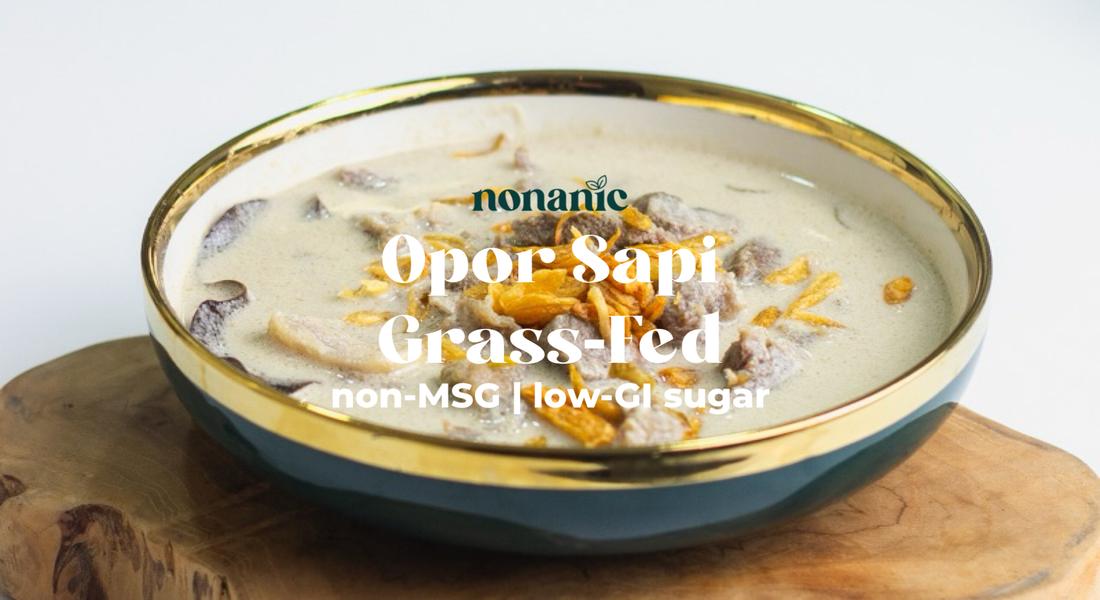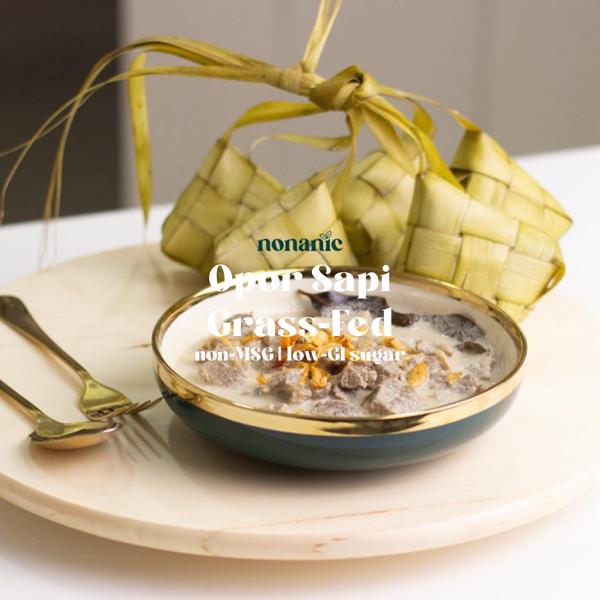
Opor Sapi Grass-Fed

Hello, #BestNic! Can you believe we're already having al-Fitr! Who here has experienced answering template questions like "When is your spouse?" or "When are you bringing a plus one?" and other family inquiries? 😆
No worries.. It's better to just close your eyes and ears and focus on chasing your life goals, #BestNic. But don't close the Nonanic webpage just yet, because this time Nona wants to share a recipe for a dish that is not only super special but also healthier for you and your family for the Hari Raya.
Creamy, savory, thick. Yup, what else if not Eid opor!
To accompany the Ketupat Tiwul Nonanic whose recipe Nona shared in the previous post, this time Nona wants to share the recipe for the opor. But, of course, it wouldn't be Nonanic if the recipe didn't level up: not only delicious but also healthier. Here it is,
GRASS-FED BEEF OPOR
This low-GI and MSG-free opor will make your special day less guilty! Because this opor is made with grass-fed beef which has lower fat content than regular beef. Besides, Nona also uses pure coconut milk from one whole coconut.
You know that coconut milk is a source of good fat beneficial for your body, right? Just don't eat it by the spoonful! Huehehhe
In Nona's opinion, this Nonanic-style opor and ketupat are unmatched! Just like you 😝
So, are you ready to send Grass-Fed Beef Opor and healthy Ketupat Tiwul a la Nonanic to your future in-laws' house? Who knows, maybe after Eid, you'll get engaged. #cool
Course Main Course
Cuisine Indonesian
Keyword healthy beef stew, indonesia beeef stew with coconut milk, inodnesian opor, healthy grass-fed beef opor
Prep 10 minutes
Cook 50 minutes
Servings 6 servings
Ingredients
500 grams of grass-fed beef shank, cut as desired
½ liter of water
25 grams of shallots
12 grams of garlic
1 stalk of lemongrass
2 bay leaves
3 kaffir lime leaves (remove the leaf veins)
3 cm galangal
¾ teaspoon coriander seeds - roasted and ground
½ teaspoon cumin powder
2 teaspoons sea salt
2 teaspoons sorghum sugar
¾ teaspoon non-MSG mushroom broth
½ teaspoon ground pepper
Coconut milk (grated 1 coconut + 500ml water, squeezed)
Ingredients B (Spice Paste):
35 grams of shallots
20 grams of garlic
3 roasted candlenuts
A little water for blending
Instructions
-
Blend ingredients B until smooth.
-
Sauté shallots and garlic from Ingredients A using enough oil.
-
Then add the ground spice paste from Ingredients B.
-
Add lemongrass, bay leaves, kaffir lime leaves, galangal, roasted and ground coriander, and cumin powder.
-
Add the beef and sauté briefly.
-
Transfer to a pressure cooker, add water, sea salt, sorghum sugar, non-MSG mushroom broth, and ground pepper.
-
Cook in the pressure cooker for 20 minutes. If you don't have a pressure cooker, you can also simmer over low heat for 1-2 hours.
-
Then add coconut milk and bring to a boil.
-
Sprinkle with fried shallots.
-
Ready to be served with Nonanic's Ketupat Tiwul (click here to see the recipe )
Tips
1. If you don't have a pressure cooker, grass-fed beef can be cooked over low heat until tender for approximately 2 hours.
2. If you enjoy yellow curry, you can add turmeric to the spice paste, about the size of one finger segment, or according to your taste.
3. If you plan to store it in the refrigerator, Opor should be divided into airtight containers and can last for 1-2 days. Simply heat it until warm before consuming.
4. Grass-fed beef can be substituted with organic chicken or boiled eggs according to preference.
5. This recipe only uses thick coconut milk. The remaining coconut milk can be used to make thin coconut milk for making vegetable opor with pumpkin or cassava leaves.
Opor Sapi Grass-fed

Halo, #BestNic! Eid Mubarak to you all who celebrate 💚 Ayo siapa disini yang udah berkali-kali jawabin pertanyaan netizen, “Kapan nyusul?” atau “Kapan bawa gandengan?” dan pertanyaan-pertanyaan netizen lainnya saat kumpul keluarga kemarin? 😆
Gak papaaa..Mendingan tutup mata tutup telinga aja deh dan fokus mengejar life goals kamu, #BestNic. Tapi jangan tutup webpage Nonanic dulu ya, karena kali ini Nona mau share resep hidangan yang gak hanya super istimewa tapi juga lebih sehat buat kamu dan keluarga di Hari Raya.
Creamy, gurih, kental. Yup, apalagi kalo bukan opor lebaran!
Untuk menemani Ketupat Tiwul Nonanic yang udah Nona share resepnya di post sebelumnya, kali ini Nona mau share resep opornya dong. Tapi, tentu aja bukan Nonanic namanya kalo resepnya gak naik level: gak hanya enak, tapi juga lebih sehat. Ini dia,
OPOR SAPI GRASS-FED
Opor yang low-GI sugar dan tanpa MSG ini bakal bikin hari spesial kamu less-guilty deh! Sebab opor ini dibuat dengan daging sapi pemakan rumput yang memiliki lemak lebih rendah dari pada sapi pada umumnya. Selain itu Nona juga memakai santan kelapa asli dari satu buah kelapa utuh.
Kalian tau kan kalo santan itu adalah sumber lemak baik yang berguna bagi tubuh kamu? Asal makannya gak sepanci ya! Huehehhe
Pokoknya menurut Nona Opor dan Ketupat ala Nonanic ini ga ada duanya deh! Kaya kamu 😝
Gimana, udah siap belum kirim Opor Sapi Grass-Fed dan Ketupat Tiwul sehat a la Nonanic ke rumah calon mertuamu? Siapa tau lho habis lebaran ini, kamu lamaran. #asik
Menu Makanan Utama
Asal Masakan Indonesia
Kata Kunci opor sapi grass-fed, opor sapi low GI, opor sapi sehat
Waktu Persiapan 10 menit
Waktu Memasak 50 menit
Porsi 6 porsi
Bahan - Bahan
Bahan A:
-
500gr sengkel daging grass-fed, potong sesuai selera
-
½ L air
-
25 gr bawang merah
-
12 gr bawang putih
-
1 batang sereh
-
2 lembar daun salam
-
3 lembar daun jeruk (buang tulang daun)
-
3 cm lengkuas
-
¾ sdt ketumbar biji - sangrai, lalu haluskan
-
½ jinten bubuk
-
2 sdt sdt garam laut
-
2 sdt gula sorghum
-
¾ sdt kaldu jamur non-MSG
-
½ sdt merica bubuk
-
Santan ( 1 kelapa tua diparut + air 500ml, peras)
Bahan B (Bumbu Halus) :
-
35 gr bawang merah
-
20 gr bawang putih
-
3 butir kemiri sangrai
-
Sedikit air untuk memblender
Cara Membuat
-
Blender bahan B sampai halus.
-
Tumis bawang merah dan bawang putih di Bahan A memakai minyak secukupnya.
-
Lalu tambahkan bumbu halus dari Bahan B tadi.
-
Masukkan sereh, salam, daun jeruk, lengkuas, ketumbar sangrai yang telah dihaluskan dan jinten bubuk.
-
Masukkan daging lalu tumis sebentar.
-
Masukkan kedalam presto, tambahkan air, garam laut, gula sorghum, kaldu jamur non-MSG dan merica bubuk.
-
Masak dalam presto selama 20 menit. Jika tidak ada presto bisa juga rebus pakai api kecil selama 1-2 jam.
-
Setelah itu masukkan santan sampai mendidih.
-
Taburi dengan bawang goreng.
-
Siap disajikan bersama Ketupat Tiwul-nya Nonanic (Klik disini untuk lihat resep Ketupat Tiwul )
Tips
1. Jika tidak memiliki presto, daging grass-fed dapat dimasak dengan api kecil sampai empuk kurang lebih selama 2 jam.
2. Jika menyukai opor kuning, dapat menambahkan kunyit pada bumbu halus sebanyak 1 ruas jari atau sesuai selera.
3. Jika ingin disimpan di dalam kulkas, Opor sebaiknya dibagi ke dalam wadah kedap udara, dapat bertahan selama 1-2 hari. Cukup dipanaskan sampai hangat saja sebelum dikonsumsi.
4. Daging sapi grass-fed, dapat diganti dengan ayam organik atau telur rebus sesuai selera.
5. Resep ini hanya menggunakan perasan santan kental, sisa perasan kelapa dapat dimanfaatkan untuk membuat santan encer untuk pembuatan opor sayur labu atau daun singkong.





